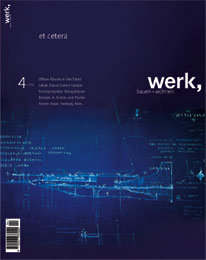Editorial
Editorial
The editors of architectural magazines are in little danger of running out of material. It is a well-known fact that building never comes to an end, and there is hardly another discipline with such a wide range, comprising both concrete practice and abstract theory, as well as being both autonomous and obedient to social and rational criteria. It is therefore not surprising that we are only able to report on comparatively few facets of this enormous variety, nor that such reports are usually placed under a superordinate heading. For things worth talking about are usually relevant to a greater whole over and above the single phenomenon: to interpret is to contextualise. It is our aspiration to discover and present such contexts, such „greater wholes“, in the midst of the proliferating variety of our discipline. Of course, it is this very variety that is one of architecture's most fascinating aspects, and we want our magazine to provide enough space and freedom for abundant discussion of many facets, neither apologetically on the back pages nor by forcing in into endlessly stretched thematic parentheses. We will therefore occasionally publish issues that invite the reader to a stroll rather than to a theme-orientated excursion. Not all these strolls will take us halfway round the world as this issue does with its contributions from São Paolo, London, Boston, as well as Biel, Chur, Landquart, and even Peiden-Bad. What will remain the same, however, is that these issues will start with an substantial main contribution; here, it is a report on architecture in São Paulo by Annette Spiro, who has already contributed to an understanding of the work of one of the city's leading architects, Paolo Mendes da Rocha, in her brilliant monograph published last year. This overview is supplemented by Andrea Deplazes with a personal view seen through the eyes of a recently converted Brazil aficionado. From tropical exoticism, our journey takes us to the familiar realm of Swiss office construction, a theme that is supposedly long since squeezed out, in order to introduce an urban planning challenge, on the example of an office building in Biel, and to discuss questions of the representative function of company headquarters in Chur, Landquart and Wallisellen. Finally, reports on two bridges in Boston and Peiden-Bad in Canton Graubünden throw some new light on the somewhat neglected theme of architectural reporting on bridge building. It would appear to be clear enough that, in spite of all geographical distance, we welcome thematical proximities in the „et cetera“ magazines as well. Less evident, but no less important, is the invitation to engage in dialogue, for which the openness of these magazines should also stand.
The editors
